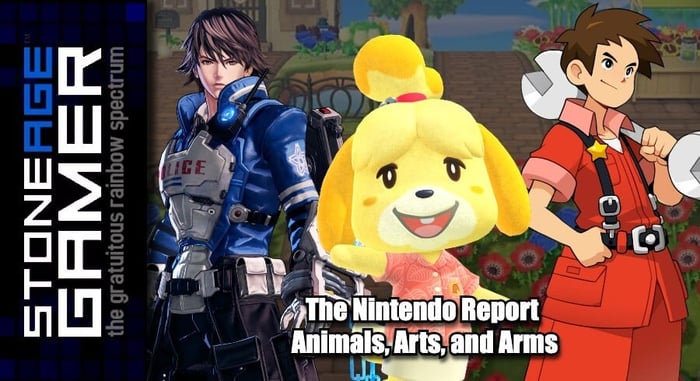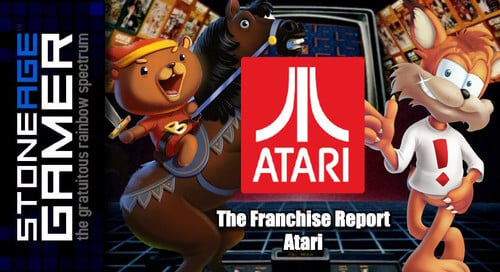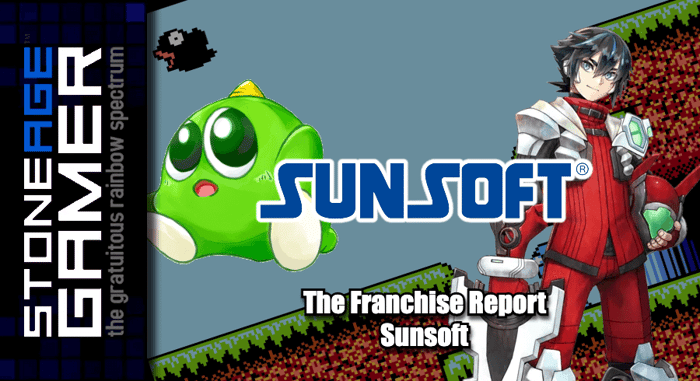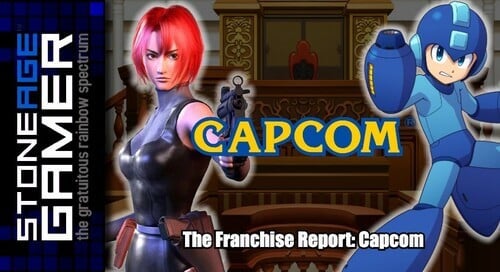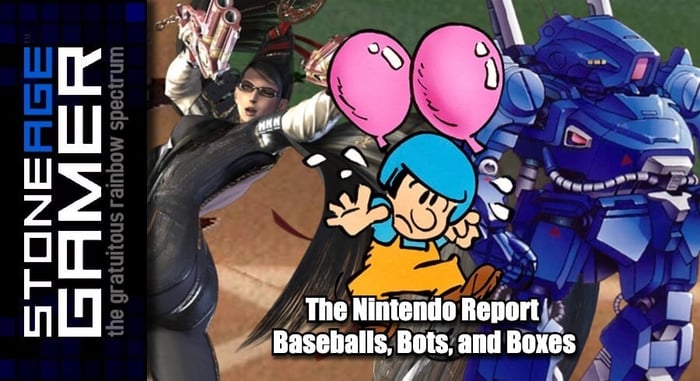
The Nintendo Report: Baseballs, Bots, and Boxes
Welcome back to The Nintendo Report, where we’re taking a look at Nintendo’s intellectual properties and seeing how they’re doing. This is a company that has an astronomical number of brands under its belt, but for reasons defying logic (at least in my mind) only keeps a small number of them active at a time. Last time we covered the letter A (and numbers) so that leaves us with the letter B this time around. Let’s see how the Big N has been treating their franchises that start with the second letter of the alphabet.
Balloon Fight/Kid
The original Balloon Fight was released early on in the Famicom’s life, and made it stateside as one of their famous Black Box titles. It’s a play on the classic arcade title Joust, and was rumored to have been created after Satoru Iwata made a version of Joust to pitch Atari on releasing the NES in the US with their branding. Regardless of its origins, the game is an all-time classic and still a blast to play today, especially in multiplayer. It’s also got one of the most memorable tunes in the entire NES library.
Health rating: Alive, but not exactly living
Balloon Fight actually got a full blown followup on Game Boy in the form of the brilliant but tragically overlooked Balloon Kid. It basically took the Balloon Trip mode from Balloon Fight and turned it into its own platformer of sorts. The music was again done by Hiorkazu Tanaka, and he expanded on his amazing Balloon Fight tunes to great effect.
But that was pretty much it. Balloon Fight has been referenced dozens of times in various Nintendo projects over the years, including providing aspects of the Animal Crossing Villager’s moveset in the Smash Bros. games, and its own attraction in Nintendo Land for Wii U, but as far as actual follow ups, nothing. Which is a real shame because if you’ve ever played Balloon Fight, you know there’s a lot of potential in that gameplay style. Of course Ballon Kid was given a full color makeover on Game Boy Color and rebranded on Famicom in Japan as a Hello Kitty game, which I suppose isn't nothing. It’s not forgotten, but it’s on life support at best.
Baseball
No, I’m not talking about Mario Baseball. I mean actual baseball, a sport that Nintendo has quite a history with. The original Baseball on Famicom was a heck of a system seller in Japan when it debuted, and while it didn’t move the needle to the same degree, its Game Boy follow up performed pretty darn well too. Nintendo themselves eventually bought a piece of the Seattle Mariners, which led to a number of Major League Baseball games starring Ken Griffey Jr. on both the Super NES and Nintendo 64.
Health rating: Surprisingly and suddenly dead
Simulated Stereo AV Cable for NES

$11.99
This cable will give your original Nintendo NES Console Stereo sound! Most modern TVs have two inputs for audio, a left and a right. Normally...… read more
Nintendo had a first party baseball game on just about every console they made, ending with Ken Griffey Jr’s Slugfest for Nintendo 64 in 1999. But stopping there clearly wasn’t their original intent. At E3 2005, Nintendo showed off a nearly complete game called Nintendo Pennant Chase Baseball for GameCube. There was box art featuring David Ortiz, and an official MLB license. It seemed like everything was good to go, and according to an interview with the game’s senior engineer said the game was “completed and passed submission, but was not released.” So what the heck happened? Nobody knows. And that’s the last time Nintendo played baseball. While it’s true that MLB The Show is a great baseball game, it sure would be nice to see some actual competition in the sports game arena again. Maybe they’ll try again someday?
Battleclash
Nintendo had a pretty interesting take on the light gun concept for the Super NES. Instead of some sort of handheld pistol like basically every video game system dating back to the Atari days had, they decided to make a freaking bazooka and call it the Super Scope. It’s actually a really fun peripheral to use, especially if you’ve got the right game.
Battleclash was indeed the killer app the Super Scope needed. Playing out sort of like a game of Punch-Out!! except in giant flying robots with guns, Battleclash was a bright, beautiful, action-packed light gun extravaganza that’s an absolute blast (pun very much intended) to play.
Health rating: Basically dead
Unfortunately for Battleclash, Nintendo did a terrible job of following it up. It had a direct sequel, but you’d never know it by looking at the box. In a move that I can only assume was made in order to capitalize on the immense popularity of Mortal Kombat, the game was called Metal Combat: Falcon’s Revenge, and as far as I know basically nobody bought it. Not that the Super Scope had that huge an audience to begin with, but for as many copies of Battleclash I’ve seen out in the world, I’ve seen far fewer copies of Metal Combat. It’s a real shame too because it’s a pretty great sequel that follows the same lore, and has some rather clever multiplayer ideas.
Light gun games aren’t really a thing anymore, so I’d be shocked if we ever saw Battlecalsh again. Though it did get a spirit battle in Smash Bros. Ultimate, so I guess anything’s possible!
Bayonetta
Bayonetta isn’t really a Nintendo franchise, except now I guess it kind of is? The character is owned by Platinum Games, but Nintendo funded and published the last three entries in the series, so their stake in the brand is considerable to say the least.
Bayonetta is a 3rd person action game about a witch whose body is covered in hair that she can turn into demons or something. I’ve beaten the first two games front to back and I still couldn’t tell you exactly what the story is actually about, but I can’t say I really care. Bayonetta is all about over the top action, which it does with extraordinary style.
Health rating: Pretty great
Baonyetta was in a bad way after the first game failed to properly take off on PS3 and Xbox 360. But Platinum Games really wanted to make a sequel, and Nintendo of all companies jumped on board and made it happen. And Bayonetta 2 is freaking spectacular! It was also a complete flop because it was released exclusively for Wii U. Thankfully, Nintendo re-released it on Switch, followed by yet another sequel and a weird spinoff called Bayonetta Origins: Cereza and the Lost Demon. Series creator Hideki Kamiya left Platinum Games in 2023, so the future of the franchise is a bit up in the air, but I don’t expect Nintendo and Platinum to leave this one alone for very long.
Big Brain Academy
Brain Age for Nintendo DS was an absolute powerhouse in terms of sales. So naturally, Nintendo wanted to capitalize on that craze with something a little more family friendly. Not that Brain Age was M-Rated or anything, just that it was a little dry in terms of presentation. Big Brain Academy was more cartoony and colorful. It was a way to make the whole brain training fad into something the whole family could enjoy, and wouldn’t you know it, the game sold a bajillion copies as well.
Health rating: Pretty good
Big Brain Academy for Nintendo DS got a sequel on Wii called Big Brain Academy: Wii Degree, which also sold very well. Then in 2021 Nintendo released Big Brain Academy: Brain vs. Brain for Switch, which unfortunately sold a mere fraction of its previous iterations. Don’t get me wrong, it still moved just shy of 2 million units, which I imagine means the game was still quite profitable, but when you compare it to the nearly 6 million the original DS game sold, it’s small potatoes. Still, the game is really fun and reviewed reasonably well. I’ll bet we’ll see more in the future.

bitGenerations/ArtStyle
If you’ve heard of these games and you live in North America, you probably know them as ArtStyle, but this series actually harkens back to the Game Boy Advance, where the first seven games were released under the bit Generations banner back in 2006. They were developed by Skip Ltd., and all feature simple gameplay loops centered around a minimalist art style. They’re fun, addictive, and range in quality from good to holy-cow-why-have-I-never-heard-of-this!
Health rating: Basically dead
When Nintendo brought the series to the US, they rebranded it ArtStyle and put them on their various digital shops on Wii and DSi. There were 12 games released under the banner between those two platforms, but it seems the series died there. This is super unfortunate because the Switch eShop could really use more quality pick up and play games instead of the deluge of mobile phone garbage that clogs its pages now. In particular, ArtStyle PiCTOBiTS is one of the most fun and addictive puzzle games I’ve ever played, and needs to find its way into more hands someday. Skip Ltd. is still around, so maybe they’ll come back eventually, but I doubt it.
Box Boy
HAL Laboratory is a wonderful company that makes wonderful games. They've been around forever, and are probably best known for being the force behind the Kirby franchise. But where Kirby is a round little guy with very few other features, Qbby is a square little guy with very few other features! His first adventure, BoxBoy, released on Nintendo 3DS and is a super charming puzzle platformer. It’s also monochrome, yet still manages to feel super alive. Leave it to the geniuses at HAL!
Health rating: Could be better
BoxBoy seemed to have a lot going for it for a while there. There were two sequels on 3DS that seemed to perform reasonably well, and then a super fun sequel on Nintendo Switch called BoxBoy! + BoxGirl!. There was even an amiibo made for the game in Japan! But alas, the Switch game seems to have not performed very well, and the amiibo never saw release outside of Japan (making it super sought-after here in the states, typically fetching well over $200-300 on the aftermarket). The BoxBoy games absolutely have an audience though, and knowing HAL, I doubt they’ll just give up on the franchise forever. I’m confident we’ll see Qbby and his angular friends again someday.
Brain Age
When Nintendo launched the DS, the goal was to apply what they called a Blue Ocean strategy. They wanted to try and make video games appeal to casual non-gamers, and one of their first massive successes in that regard was Brain Age. It’s a basic brain training game wrapped up in a charming package that utilizes the DS’s touch screen to recognize handwriting. There were voice activated games too, and it was a genuine phenomenon, selling about 32 bazillion units.
Health rating: Hard to say
Brain Age spawned a number of sequels on Nintendo’s various platforms, including most recently the Switch. But not in the US for some reason. Dr. Kawashima's Brain Training still hasn’t had any sort of proper release in North America, which kind of calls the series stability into question. If it was a localization thing I could understand that, but the game has already been translated into english. So what’s the deal? It’s impossible to know for sure. At the very least, it might be done for in the US, but as for the rest of the world, we’ll have to wait and see.
And that wraps up part 2. Nintendo’s got a pretty decent amount of B games under its belt, and honestly too many of them have uncertain futures. But as we’ve seen time and time again with Nintendo, you never know what they’ll dig up next. Any one of these games could be next! Join us next time as we dive into the letter C where we’ll check in with robots big and small, a battle-ready Abe Lincoln, and some really fast cars.


